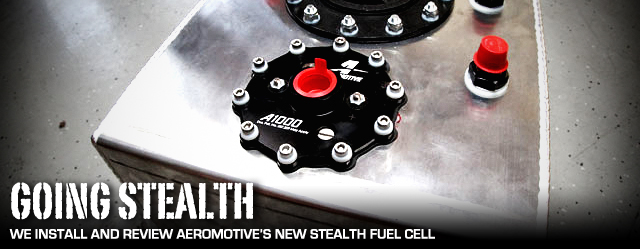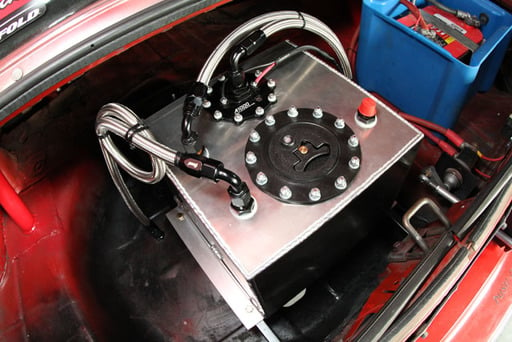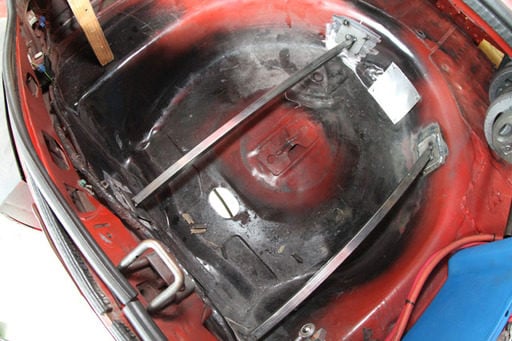
Our Project 666, a Fox body Mustang that once got its motivation from the famed 5.0L HO V8 engine – which in ’86, received sequential multi-port fuel injection to replace the age-old 4V carburetor – has been one of powerTV’s longest continuous project cars out in the shop. The lengthy project, however, hasn’t been one long drawn out build, but one that’s gone through various transformations as our end goal for the alpha domestic muscle car evolves.
When we first began on 666, the vision for its final result was one of humble intentions. We aimed to build a wicked Fox body that was right at home on both the street and the strip, incorporating many of the “race” elements into the suspension and drivetrain, while maintaining some level of drivability, as well. But as would be expected from a group of editors with deep roots in drag racing, 666 gradually took on a new form.
The 408ci Small Block Ford that we had in the car gave way to an all-aluminum 427 from Dart, along with TCI’s new C4 transmission, new suspension components, and other changes. Throughout the build, we’ve taken this Pony car from the 13’s to the 12’s, down to the 10’s and finally, after more late nights and busted knuckles than we can keep track of, into the nines. And while the nines were a big mission of ours, we’re drag racers, and we’d be in defiance of the code of a drag racer if we just stopped there. And so our project matches on, where we turn our attention next to the fuel system. For that, we’ve again teamed with Aeromotive, whose fuel system components can be found front to back on our Project 666.
666’s Current Setup
 Regular visitors to StangTV and those following the progress on 666 may know what the current spec sheet looks like on this car, but to get you up to speed, a couple of years back, we installed Aeromotive’s then-new Stealth fuel tank, which satisfied our needs at the time with 800 horsepower potential, compatibility with EFI or a carburetor, and no losses in street-ability or fuel capacity.
Regular visitors to StangTV and those following the progress on 666 may know what the current spec sheet looks like on this car, but to get you up to speed, a couple of years back, we installed Aeromotive’s then-new Stealth fuel tank, which satisfied our needs at the time with 800 horsepower potential, compatibility with EFI or a carburetor, and no losses in street-ability or fuel capacity.
The Stealth system featured an OE-designed fuel tank with a fully-contained, sump-style fuel pump and filter located within the tank. Because of its mounting point that drops down two inches from the lowest point on the stock tank, it proved to have ideal fuel pickup on acceleration and an optimum gravity pickup point – something not previously possible with aftermarket fueling options on the Fox body. But as we take more of a full-on race car approach to 666, it was time to take a full-on race approach to our fuel cell.
Aeromotive’s New Stealth Fuel Cell

Aeromotive's new six-gallon Stealth fuel cell, which was originally designed to be standard hardware on the Ford Cobra Jet Mustang, is an aluminum, racing-style cell with an internal A1000 fuel pump.
As a race car, the new Stealth fuel cell offers 666 a number of advantages; it’s lightweight, it has a decreased fuel capacity, is designed for drag racing, and carries the option of a couple of Aeromotive’s top-notch race fuel pumps. Constructed of aluminum, the tank holds six gallons of fuel and offers many of the same advantages of the larger 15 and 20 gallon tanks, with the exception of carrying a street-style sending unit. Very much a universal design, the Stealth tank is a sump-style part with Aeromotive’s A1000 fuel pump – or the option of the Eliminator fuel pump – built right into the tank. It also features an integrated baffling system to keep a column of fuel at the pickup point to eliminate fuel slosh issues.
“Right before we began production on the first generation tanks, we began working with Ford on the Cobra Jets, and they said, we want you guys to do the fuel system,” explained Aeromotive’s Jesse Powell. “We decided it would be best to do an in-tank version, so that you don’t need an externally-mounted fuel pump. The engineers loved it and we collaborated to arrive at the six gallon capacity. This Stealth tank has now been standard on the last two iterations of the Cobra Jet and can also be found on Chevrolet’s COPO Camaro concept.”
The smaller, universal six-gallon capacity of the new aluminum Stealth fuel cell is perfect for our Project 666, which has become a real strip warrior in recent months. The new cell offers many of the advantages found in the larger OE-style tank, but uses an aftermarket sending unit.
Either of the fuel pumps – the A1000 or the Eliminator – can perform in anything from a 300 horsepower carbureted application to an EFI motor making 1,700 horsepower, so all of our bases are covered from a fuel delivery standpoint with this new setup.
With this design, you’re not uncovering the pickup when you’re turning left or right, hard braking, or hard acceleration, and it keeps positive pressure on the inlet to reduce vapor lock problems.
The Stealth fuel cell sports an A100 Micron stainless steel fuel filter, return line provision, a pair of AN-08 vents with rollover valves for rollover ventilation, and a standard 12-bolt flush mount lid assembly. Internally, the cell design sports a “box” that contains the fuel pickup and filter and also the return that, even when low on fuel, is always overflowing with fuel – much like a garden hose being run into a cup. This maintains a continuous flow of fuel at the pickup at all times.
“With this design, you’re not uncovering the pickup when you’re turning left or right, hard braking, or hard acceleration, and it keeps positive pressure on the inlet to reduce vapor lock problems,” explains Powell.
Aeromotive Stealth 6-Gallon Fuel Cell Features:
Eliminator Fuel Pump (internal) – P/N 11104
• 100 Micron Stainless Steel Fuel Filter
• 6.2 Gallon Capacity
• Return Line Provision
• (2) AN-08 Vents with Rollover Valves
• Standard 12-Bolt Flush Mount Lid Assembly
• Natural Aluminum Finish
Out With The Old, In with The New
As is commonly done with a car such as ours where the original trunk is still fully intact, we’ll be relocating the new Stealth fuel cell to the trunk rather than under the car where the current Aeromotive OE tank resides. But in order to do so, we’ve got a little work to do to make preparations. Before we can get to the installation, however, we need to remove the old tank, which is little more than a process of removing the return and supply lines from the filter and pump, removing the filler neck assembly, disconnecting the sending unit lines, and undoing the straps that hold the tank in place under the car.
We've opted to use the recessed spare tire compartment in the trunk to mount the new fuel cell. With a pair of 3/4-inch square tubing welded parallel into the compartment, we then welded a pair of L-brackets to the opposite sides of the tank, which will rest on the square tubes for mounting.
From there, we turn our attention to the trunk of 666, where we’ll need to fabricate a pair of mounts to firmly place the tank and bolt it down to. Sean, our resident fabricator and mechanical wiz, took a pair of 3/4-inch square tubing, sized them down appropriately, and welded them parallel to one another down into the recessed spare tire compartment in the trunk. Two L-brackets were then welded to the lower edge on each side of the tank with two bolt holes cut through each. The tank could then be placed on the 3/4-inch rails and bolted down.
Then it was matter of modifying our plumbing configuration to reach the tank – now in the trunk – using the supply, return line, and sending unit wire that we already had in place. To accomplish this, a pair of fuel line bulkhead fittings were placed in the floor of the trunk.

Here's the fruit of our labor, with the new lines re-routed through a pair of bulkheads in the trunk floor to the tank and the stock sending unit wire, also re-routed through the tank from the undercarriage of the car. Armed with a pair of rollover vents, we've optioned to seal one off, while routing the other out through the floorboard of the car.
On the supply side, the hose was cut to place a new inline fuel filter on the line, and then both the supply and return lines were connected to one side of the bulkheads, while a new pair of fuel lines were connected to the trunk side of the bulkheads and run up to the new Stealth fuel cell. As mentioned above, we re-used the sending unit wire, and only had to re-route it up through the trunk to the new tank. Lastly, because we only need one of the two rollover vents that come standard on the Stealth fuel cell, we capped one of the AN fittings off, and with a loop in the line as is common, routed it out the floorboard of the car.
While the switch from our previous OE-style fuel tank to this legitimate racing tank from Aeromotive may be a rather small ingredient to the whole picture, the result of our work on this, the brains of the fuel system, brings 666 one step closer to it’s performance potential and true identity as a race car. Along the way, we gained some added performance potential with the awesome A1000 pump, reduced some weight from the car, and improved our level of safety a touch with the optional two rollover vents. Now it’s time to fill up and hit the track!





















